Dear members of the Diyaudio forum,
I am happy to write this message to you to share my experiences with my project. It's hard to say where the story started as the whole project has changed in development and processes over the past few years but has finally gotten to a point where I can settle down and just enjoy it.
In this message I will write about the different phases of the last few years ...
Speaker:
Prehistory:
The project started with the idea of upgrading my DIY speaker: Gainclone + active crossover (built into the speaker) Hivi S6.R + Fountek NeoCD3.0
Currently:
Since I was satisfied with the sound of the Gainclone at first, I focused on the new speaker. I knew that the whole project can be done step by step, but it was also clear to me that I am not the endlessly patient guy who can spend months or years without a result that I enjoy, so have to the speakers be standalone (with no built-in electronics) and also must be bi-amp design like the previous one.
Technical Details:
Mundorf AMT23CM1.1-C
SB Acoustics Satori MW16P
The speaker was built in 2016. Bi-amp design drivers connect directly to the terminals.
Right from the first listen I was very happy with the sound of the speakers including the dynamics, the details and not the latest natural soundscape, to be honest, since I built it, didn't change or modify anything, I'm still very happy.
Amplifier:
First version:
4x Gainclone
LCDuino-1
δ1 relay-based stepped attenuator
δ2 relay-based input/ouput selector
Elliott Sound Products p09 24dB/Octave 2/3-Way Xover
Elliott Sound Products p88 Audiophile quality preamp
Due to the move in the meantime Sonitus Acoustics absorbers and bass traps came to help and it also became clear that a DSP cloud is doing a magic to correct some major anomalies in the room. The first attempt was the Minidsp 2X4HD with REW. The correction was very good on paper, but somehow the sound lost its natural feel, somehow it sounded like a "calculated" sound image. As I read on, I thought I should switch DSP processing to Dirac Live ... and I kept it!
Sneak Oil or not?
The company I work for has joined a Canadian-American distributor. I went to an exhibition where our company was on the same booth with Focal, Isoacoustic, SPL, Vovox.
During the exhibition, I made a very good connection with the very positive people who belong to this company.
To be honest, I was very skeptical about Sneak Oil but still open to information about what my ears are telling me.
During the exhibition I spoke to two technically and personally very positive people. Namely Dave Morrison (Isoacoustic) and Jürg Vogt (Vovox). When we talk about sneak oil and technology, it's all about perspective and definition but they aren't the same. But in the end, the fact is that these things make a significant difference in positive ways. (I'm not going to cheat myself!) Talking to these people, too, it became clear that this is not a marketing strategy, but a lifelong passion combined with technology that can leave words unexplained, but ears and bodies demonstrably positive changes.
When I got back from the exhibition, I was convinced and started looking for options for these products that would best suit me.
Isoacoustic - Aperta
Very positive and I like the product so much (think my neighbors love it too) as it seriously isolates the speaker power from the surroundings. The energy definitely stays in the speakers instead of transferring to the floor. The result is more energy and a clearer sound.
Vovox
Well, due to the bi-amp design of my speakers (let's call it a downside from this perspective), upgrading to Vovox would be expensive. This upgrade will be a dream for the future ...
A few months later, I became a very lucky person to be able to contribute for Vovox to the Swiss Alps to do the longest guitar cable experiment in the world. Oh wow seriously 596m guitar cable?
Well done -> The world's longest guitar cable - YouTube
Jürg is a very nice person , he sent me sample cables to the demo so that I could try them out with my system. Well, when I turned on my system it immediately became clear that sending the demo cables back was going to hurt - it was true. The danger of such a demo is that if you try something that makes a very positive change, you will be happy. However, when I had to send the cables back, I felt like I was missing something.
Yeah well, I chose Vovox Sonorus for the Low and Vovox Textura cables for High.
The decision and the order has been made ....
An upgrade followed next year in which I exchanged the gainclones for Tripath TA2022
It was different ... but positive
My first long term experience with class D (in my house)
That was the phase where I finally wanted to put it in a final case, but somehow it never happened ... Somehow, I was sure it had something more to do with the system.
Current status of the project:
Instead of the case design, I was more interested in class D amplifier modules, and at the same time also in how minimal the design can be.
Wait a minute ... Minimal?
My source is Cambridge Audio 851d so I basically have a preamp; Volume control; Input selection.
I have DDRC24 so basically I have crossover too.
What do I need?
An amplifier!
So no torroids, no other power supplies, no soft start, no crossover, no preamplifier, no input selector and no step-by-step volume control?!
The project took a completely new direction.
Components:
1x MiniDSP miniDC 12V Isolator Ignition Sequencer
Accessories : miniDC Isolator
1x DDRC24
Dirac Series : DDRC-24
1x BalBUF PSU
Project files: The BalBUF and PSU | theslowdiyer
2x ASX buffers
Project files: Opamp buffer for ICEpower ASX-modules | theslowdiyer
1x ICEXTEND
https://www.profusionplc.com/parts/icextend
2x ICEpower125ASX2
https://www.profusionplc.com/parts/icepower125asx2
HiFi2000 Slim Line
https://modushop.biz/site/index.php?route=product/product&path=120_246_249&product_id=102
In my project I use the 12V from 851d to trigger miniDC and the delayed 12V to start the amplifiers. Yes, I could use this 12V to trigger the amps directly (mute only) but since I had enough space in the case, I chose ICEXTEND to not only keep the amps mute but to turn them off completely when they are not used. (less standby power + longer lifetime)
The project started with some fixtures like DDRC24 and 125asx2 and during the planning process I found that the 125asx2 is a very good amplifier if the source can drive it properly. That would be a direct connection from 851d to 125asx2, but I have DDRC24 between. Then I also need something that will help with the impedance mismatch as the DDRC24 has a relatively high output impedance.
I got very good support from Pascal in completing the project. Very big thanks for this! He helped me to point out that using BalBUF PSU and 2x ASX-Buffer would be a solution that can be built in without other additional cards or power supplies. Basically, the BalBUF PSU is supplied by the AUX of the 125asx2. The 2x ASX buffer can be chained together thanks to the beautiful design to keep the wiring short and simple.
Due to a limited auxiliary power current, there is no way to supply the DDRC24 from the AUX 125asx2, and unfortunately the ICEXTEND has a 5V 1A AUX supply so that this is not enough to supply the DDRC24 with 12V ~ 300mA.
I chose to use an external power supply because I built in the miniDC card which not only contains the ignition sequence but also DC isolator.
The inputs are connected to the DDRC24 inputs and the outputs to the ASX buffer and then to the 125asx2. One amplifier drives the L&R High frequency range, the other amplifier drives the L&R Low frequency range.
Due to the enough space in the housing, I opted for ClarityCap ESA47uF as protection for the high-frequency drivers.
The housing is HiFi2000 Slim Line (all aluminum). The design created by me. I sent the design to modushop.it, where I had very good and supportive communication with Gianluca. The case arrived and in a very short time after I placed the order, the quality of the case including the cutouts is five stars, I am very happy with it.
The enclosure has a 10 mm front panel and a 3 mm top panel. The assembly of the housing is very simple and the removable and adjustable base plate makes it easy to install the circuit boards.
In the internal layout, the goal was to achieve the greatest possible separation between signal boards and possibly noisy parts. It is time consuming to make the correct length of internal wiring, but it is worth it because then the wires will not cross internally, which will also help isolate signal cables from others.
I know the extra heat sink is not must to, but since I had enough space, I installed an extra heat sink on top of the two amplifier boards.
The first start was very easy and straightforward, the 125ASX2 is very quiet in standby mode and the way it sounds is amazing. Significantly higher Dynamics, no matter where I turn the volume control. I mean there is so much detail and dynamics even at low volume - which also requires a high sensitivity speaker, but I have no complaints on Mundorf or SB - this is one of the best parts of this amplifier. The clarity and detail have also improved a lot compared to my previous system. The depth of the sound also offers a much broader stage for playing.
Talking about the best parts...
What I also like is the naturalness, which is exactly why it is difficult to say what I like about it because it just feels "at home". Warm enough to feel cozy, but powerful and fast enough to be modern. Yes, that's adds on to the pleasure of having it in the enclosure and ready... now I feel ... I don't want to open it, just listen.
Some photos and some technical details are included below
Cheers,
Laszlo
I am happy to write this message to you to share my experiences with my project. It's hard to say where the story started as the whole project has changed in development and processes over the past few years but has finally gotten to a point where I can settle down and just enjoy it.
In this message I will write about the different phases of the last few years ...
Speaker:
Prehistory:
The project started with the idea of upgrading my DIY speaker: Gainclone + active crossover (built into the speaker) Hivi S6.R + Fountek NeoCD3.0
Currently:
Since I was satisfied with the sound of the Gainclone at first, I focused on the new speaker. I knew that the whole project can be done step by step, but it was also clear to me that I am not the endlessly patient guy who can spend months or years without a result that I enjoy, so have to the speakers be standalone (with no built-in electronics) and also must be bi-amp design like the previous one.
Technical Details:
Mundorf AMT23CM1.1-C
SB Acoustics Satori MW16P
The speaker was built in 2016. Bi-amp design drivers connect directly to the terminals.
Right from the first listen I was very happy with the sound of the speakers including the dynamics, the details and not the latest natural soundscape, to be honest, since I built it, didn't change or modify anything, I'm still very happy.
Amplifier:
First version:
4x Gainclone
LCDuino-1
δ1 relay-based stepped attenuator
δ2 relay-based input/ouput selector
Elliott Sound Products p09 24dB/Octave 2/3-Way Xover
Elliott Sound Products p88 Audiophile quality preamp
Due to the move in the meantime Sonitus Acoustics absorbers and bass traps came to help and it also became clear that a DSP cloud is doing a magic to correct some major anomalies in the room. The first attempt was the Minidsp 2X4HD with REW. The correction was very good on paper, but somehow the sound lost its natural feel, somehow it sounded like a "calculated" sound image. As I read on, I thought I should switch DSP processing to Dirac Live ... and I kept it!
Sneak Oil or not?
The company I work for has joined a Canadian-American distributor. I went to an exhibition where our company was on the same booth with Focal, Isoacoustic, SPL, Vovox.
During the exhibition, I made a very good connection with the very positive people who belong to this company.
To be honest, I was very skeptical about Sneak Oil but still open to information about what my ears are telling me.
During the exhibition I spoke to two technically and personally very positive people. Namely Dave Morrison (Isoacoustic) and Jürg Vogt (Vovox). When we talk about sneak oil and technology, it's all about perspective and definition but they aren't the same. But in the end, the fact is that these things make a significant difference in positive ways. (I'm not going to cheat myself!) Talking to these people, too, it became clear that this is not a marketing strategy, but a lifelong passion combined with technology that can leave words unexplained, but ears and bodies demonstrably positive changes.
When I got back from the exhibition, I was convinced and started looking for options for these products that would best suit me.
Isoacoustic - Aperta
Very positive and I like the product so much (think my neighbors love it too) as it seriously isolates the speaker power from the surroundings. The energy definitely stays in the speakers instead of transferring to the floor. The result is more energy and a clearer sound.
Vovox
Well, due to the bi-amp design of my speakers (let's call it a downside from this perspective), upgrading to Vovox would be expensive. This upgrade will be a dream for the future ...
A few months later, I became a very lucky person to be able to contribute for Vovox to the Swiss Alps to do the longest guitar cable experiment in the world. Oh wow seriously 596m guitar cable?
Well done -> The world's longest guitar cable - YouTube
Jürg is a very nice person , he sent me sample cables to the demo so that I could try them out with my system. Well, when I turned on my system it immediately became clear that sending the demo cables back was going to hurt - it was true. The danger of such a demo is that if you try something that makes a very positive change, you will be happy. However, when I had to send the cables back, I felt like I was missing something.
Yeah well, I chose Vovox Sonorus for the Low and Vovox Textura cables for High.
The decision and the order has been made ....
An upgrade followed next year in which I exchanged the gainclones for Tripath TA2022
It was different ... but positive
My first long term experience with class D (in my house)
That was the phase where I finally wanted to put it in a final case, but somehow it never happened ... Somehow, I was sure it had something more to do with the system.
Current status of the project:
Instead of the case design, I was more interested in class D amplifier modules, and at the same time also in how minimal the design can be.
Wait a minute ... Minimal?
My source is Cambridge Audio 851d so I basically have a preamp; Volume control; Input selection.
I have DDRC24 so basically I have crossover too.
What do I need?
An amplifier!
So no torroids, no other power supplies, no soft start, no crossover, no preamplifier, no input selector and no step-by-step volume control?!
The project took a completely new direction.
Components:
1x MiniDSP miniDC 12V Isolator Ignition Sequencer
Accessories : miniDC Isolator
1x DDRC24
Dirac Series : DDRC-24
1x BalBUF PSU
Project files: The BalBUF and PSU | theslowdiyer
2x ASX buffers
Project files: Opamp buffer for ICEpower ASX-modules | theslowdiyer
1x ICEXTEND
https://www.profusionplc.com/parts/icextend
2x ICEpower125ASX2
https://www.profusionplc.com/parts/icepower125asx2
HiFi2000 Slim Line
https://modushop.biz/site/index.php?route=product/product&path=120_246_249&product_id=102
In my project I use the 12V from 851d to trigger miniDC and the delayed 12V to start the amplifiers. Yes, I could use this 12V to trigger the amps directly (mute only) but since I had enough space in the case, I chose ICEXTEND to not only keep the amps mute but to turn them off completely when they are not used. (less standby power + longer lifetime)
The project started with some fixtures like DDRC24 and 125asx2 and during the planning process I found that the 125asx2 is a very good amplifier if the source can drive it properly. That would be a direct connection from 851d to 125asx2, but I have DDRC24 between. Then I also need something that will help with the impedance mismatch as the DDRC24 has a relatively high output impedance.
I got very good support from Pascal in completing the project. Very big thanks for this! He helped me to point out that using BalBUF PSU and 2x ASX-Buffer would be a solution that can be built in without other additional cards or power supplies. Basically, the BalBUF PSU is supplied by the AUX of the 125asx2. The 2x ASX buffer can be chained together thanks to the beautiful design to keep the wiring short and simple.
Due to a limited auxiliary power current, there is no way to supply the DDRC24 from the AUX 125asx2, and unfortunately the ICEXTEND has a 5V 1A AUX supply so that this is not enough to supply the DDRC24 with 12V ~ 300mA.
I chose to use an external power supply because I built in the miniDC card which not only contains the ignition sequence but also DC isolator.
The inputs are connected to the DDRC24 inputs and the outputs to the ASX buffer and then to the 125asx2. One amplifier drives the L&R High frequency range, the other amplifier drives the L&R Low frequency range.
Due to the enough space in the housing, I opted for ClarityCap ESA47uF as protection for the high-frequency drivers.
The housing is HiFi2000 Slim Line (all aluminum). The design created by me. I sent the design to modushop.it, where I had very good and supportive communication with Gianluca. The case arrived and in a very short time after I placed the order, the quality of the case including the cutouts is five stars, I am very happy with it.
The enclosure has a 10 mm front panel and a 3 mm top panel. The assembly of the housing is very simple and the removable and adjustable base plate makes it easy to install the circuit boards.
In the internal layout, the goal was to achieve the greatest possible separation between signal boards and possibly noisy parts. It is time consuming to make the correct length of internal wiring, but it is worth it because then the wires will not cross internally, which will also help isolate signal cables from others.
I know the extra heat sink is not must to, but since I had enough space, I installed an extra heat sink on top of the two amplifier boards.
The first start was very easy and straightforward, the 125ASX2 is very quiet in standby mode and the way it sounds is amazing. Significantly higher Dynamics, no matter where I turn the volume control. I mean there is so much detail and dynamics even at low volume - which also requires a high sensitivity speaker, but I have no complaints on Mundorf or SB - this is one of the best parts of this amplifier. The clarity and detail have also improved a lot compared to my previous system. The depth of the sound also offers a much broader stage for playing.
Talking about the best parts...
What I also like is the naturalness, which is exactly why it is difficult to say what I like about it because it just feels "at home". Warm enough to feel cozy, but powerful and fast enough to be modern. Yes, that's adds on to the pleasure of having it in the enclosure and ready... now I feel ... I don't want to open it, just listen.
Some photos and some technical details are included below
Cheers,
Laszlo
Attachments
-
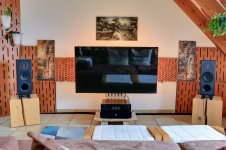 HDR_2135~2.JPG499.3 KB · Views: 453
HDR_2135~2.JPG499.3 KB · Views: 453 -
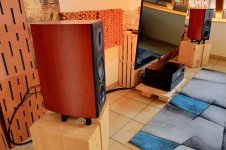 HDR_2141~2.JPG506.4 KB · Views: 448
HDR_2141~2.JPG506.4 KB · Views: 448 -
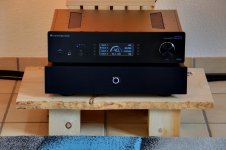 HDR_2138~2.JPG388.8 KB · Views: 450
HDR_2138~2.JPG388.8 KB · Views: 450 -
 HDR_2145~2.JPG333.8 KB · Views: 441
HDR_2145~2.JPG333.8 KB · Views: 441 -
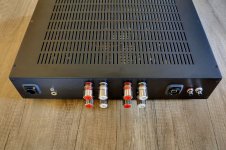 HDR_2083~2.JPG478.6 KB · Views: 444
HDR_2083~2.JPG478.6 KB · Views: 444 -
 HDR_2096~2.JPG724.5 KB · Views: 229
HDR_2096~2.JPG724.5 KB · Views: 229 -
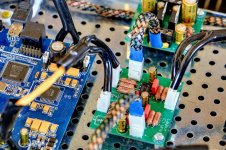 HDR_2121~3.JPG618 KB · Views: 225
HDR_2121~3.JPG618 KB · Views: 225 -
 20201116_064134_HDR.jpg792.3 KB · Views: 235
20201116_064134_HDR.jpg792.3 KB · Views: 235 -
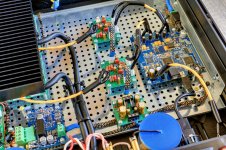 HDR_2130~3.JPG791.4 KB · Views: 231
HDR_2130~3.JPG791.4 KB · Views: 231 -
PSU+Buffer BOM 125ASX2.zip11.8 KB · Views: 95
Last edited:
Hi Laszlo,
Glad to have helped you in this project 😉
Very nice build of your combo MiniDSP/ICEPower amp !
After building my four channels amp based on 2 x 50ASX2 modules I currently own since Chrismas a Yamaha Wxa-50 amp featuring 125 ASX2 module inside 😉
Happy listening !
BR, Pascal
Glad to have helped you in this project 😉
Very nice build of your combo MiniDSP/ICEPower amp !
After building my four channels amp based on 2 x 50ASX2 modules I currently own since Chrismas a Yamaha Wxa-50 amp featuring 125 ASX2 module inside 😉
Happy listening !
BR, Pascal
You might find this video insightful:
Lohnt sich ein superteures Gitarrenkabel? Instrumentenkabel-Vergleich - YouTube
A good test and explanation of the effect of guitar cables - demystified😉
Lohnt sich ein superteures Gitarrenkabel? Instrumentenkabel-Vergleich - YouTube
A good test and explanation of the effect of guitar cables - demystified😉
I would not call such a test a insightful because it does not provide any explanation or, such a test does not prove anything. The first is that I don't have a guitar, (speaker / signal cables and levels are not the same). In the test they use a guitar in live and play more less similar samples. They have 3.2 seconds of sound to make an impression? Is that dark or bright and to prove that they measure the frequency response? But how about the rest of the spectrum and other things?
You need real golden ears if you can make a solid decision after 3 seconds of sample.
I'm thinking about the entry system, I'm not looking for a brighter or darker sound nor for big chages or quick wins, just a more natural sound. I can't even tell you what frequency response I'm looking for, not even sure is the frequency response plays major role here.
But the whole story is subjective, we have different system and room, different taste also different needs and we don't have to be of the same opinion 😉
You need real golden ears if you can make a solid decision after 3 seconds of sample.
I'm thinking about the entry system, I'm not looking for a brighter or darker sound nor for big chages or quick wins, just a more natural sound. I can't even tell you what frequency response I'm looking for, not even sure is the frequency response plays major role here.
But the whole story is subjective, we have different system and room, different taste also different needs and we don't have to be of the same opinion 😉